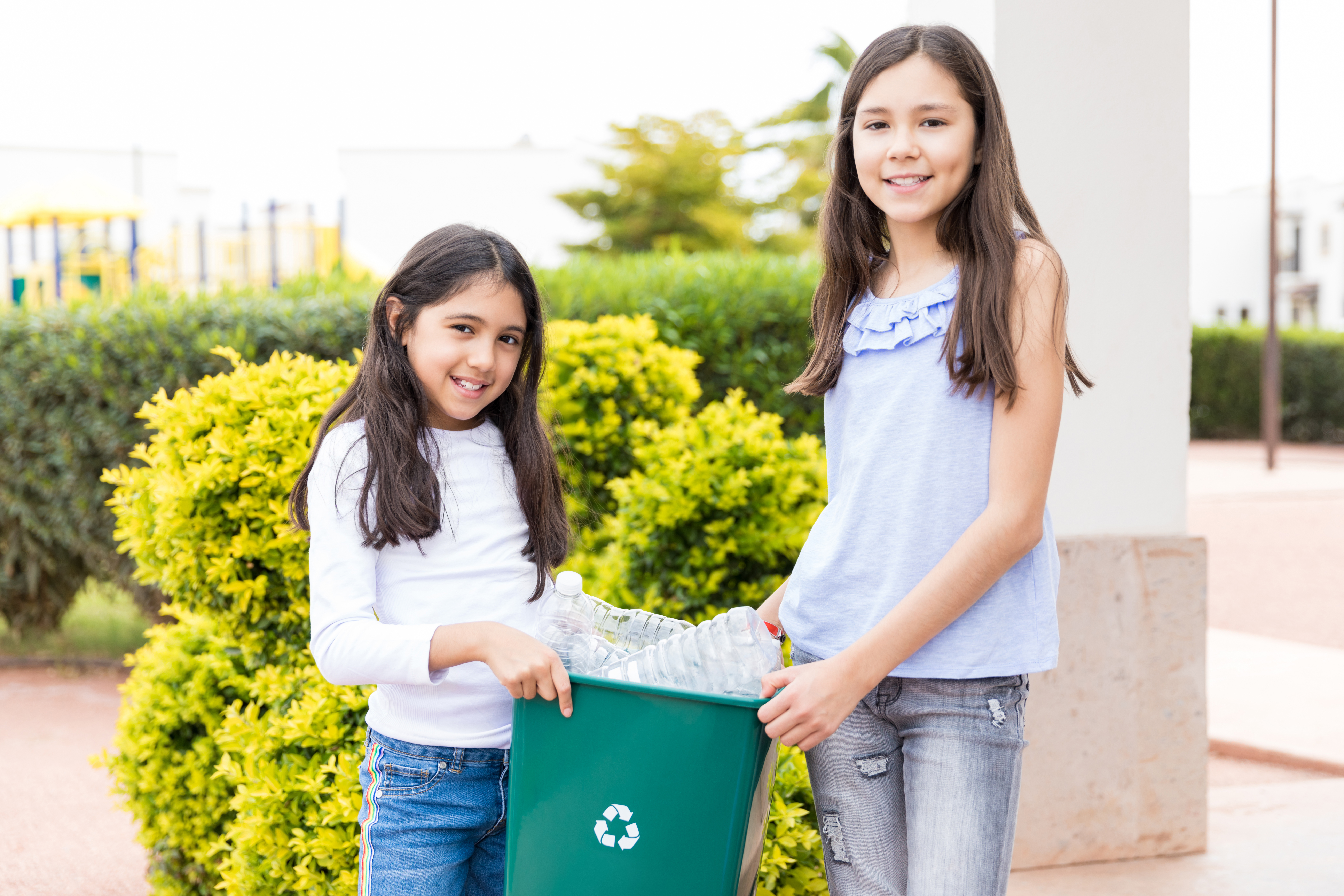There are tons of different products that require substantial packaging for distribution and consumer stores. Most of it is discarded in the wrong bin; sometimes, it is from families not considering how to recycle correctly. Forty-six million tons of paper was recycled in the US in 2018, and the number is steadily rising as more learn about the benefits and processes behind recycling.
The three steps to recycling:
- Collection
- Processing
- Transformation
This article will discuss what can get recycled, the benefits of recycling, and ways for it to be manageable in a home environment. There are three steps to recycling that kids and parents should understand before throwing anything in the bin. Some things make it easier to recycle at home; we’ll discuss appropriate cans and storage bins for different items.

What is Recycling?
This post may contain affiliate links.
Recycling is a process certain materials experience to get transformed into new products. Tons of product packaging gets thrown away into the trash. Although it may look like garbage, some can get collected and processed into new things.
Due to scarce supplies and resources, the first recorded paper recycling was in 1031 in Japan. In America, the first paper mill was created in Philadelphia in 1690. It recycled fabric, cotton, clothing, and linen to create newspaper publications. There are recycling centers for metal, wool, paper, fabrics, aluminum, glass, electronics, and plastic.
Why is Recycling Important?
There are tons of benefits to recycling! Not only do people learn about the environment, manufacturing processes, and raw materials, recycling contributes to a healthier world.
Here are more benefits of recycling.
- Landfills: Recycling collects items that would get thrown away from landfills so they have a new life elsewhere.
- Climate Change: Recycling helps decrease greenhouse gases contributing to climate change.
- Natural resources: Recycling protects timber, water, minerals, and other natural resources.
- Pollution: Recycling helps save materials used to make newer products, decreasing pollution used during manufacturing.
- Job opportunities: Since there are many recycling plants worldwide, there are increased jobs for people in the industry.
What Can Get Recycled?
There are ways that kids can help with this task at home and in the park. I know parents don’t want to care for their children’s paper or cardboard messes. Still, understanding what can get recycled will help you pass along the information and be a good role model.
Things Kids Can Recycle
- Toilet paper tubes
- Clean food containers
- Pasta boxes
- Plastic bottles
- Soda cans
- Glass bottles
- Clean milk jugs
- Construction paper
- Newspaper
- Cardboard
- Tissue boxes
- Paper
- Paper bags
- Food cans
What About Old Artwork?
Kids and parents are tempted to put old crafts in recycling because it is mostly paper, after all. However, recycling plants prefer not to recycle old art projects. Most plants don’t want tons of crayon, glue, paint, wax, staples, and sticky adhesives on drawings because it interferes with how the paper is broken down in the manufacturing plant. I recommend repurposing kids’ artwork or throwing it in the trash.
Colored pencil or ink on paper is okay, though.
How Does Recycling Work?
Explaining recycling to children doesn’t have to be weird or confusing. You may not totally understand the process yourself, and that is okay. Plenty of resources encourage proper recycling methods, so you make the best choices.
The three Rs, Reduce, Reuse, and Recycle, is the best way to improve the planet and limit waste. The last in the series, recycling, is the process that turns certain materials into other products, so they don’t end up in a landfill. Understanding recycling steps help people when they are in public, at home, and outdoor parties.
1. Collection
People at home and in the manufacturing recycling plants must separate, organize, and clean the materials before turning them into another item. Typically, people get a special can for the curb and use a specific can inside (different from the trash can) to separate it before pick-up day. Once collected in the home, it is put into the can with the corresponding logo to get sorted by another facility.
2. Processing
After the materials are sorted and cleaned, they are processed by specific machines. Each item has a different process and is usually sent to a separate plant. It is essential to sort them according to the city’s requirements so it gets sent to the correct manufacturing plant.
3. Transformation
Once the manufacturing plant receives the old packaging, it is turned into new products. This ensures that stores, markets, and clothing shops have additional products for consumers’ needs. Some materials get turned into new egg cartons; others are made into plastic containers or cardboard boxes.
What is the Proper Way to Recycle at Home?
You want to ensure you have the correct items when considering this change. There are helpful cans to keep in the house and particular cans for the outside curb.
Get the Proper Cans
When moving into a new home, most homeowners or renters must prove residency to get a free can from the city. It is crucial to have the correct can and understand the requirements for each. Some are particular colors and have logos representing the collected item. Some are for cardboard, plastic, and paper, while others are for metal scraps or outdoor gardening and compost.

It is also helpful to purchase an extra for your house, so you have one for garbage and one for recyclables. In my home, garbage and recycling cans are in different spots of the house, requiring us to consider before tossing trash mindlessly. My preferred can is this one here (on Amazon), and I have bought a few for different areas of my home to ensure there are consistent and reliable containers all around.
Separate, Clean, and Dispose
When you are indoors, you must clean the food and liquids from the containers before tossing them in. Once they are ready for the proper indoor can, I encourage my children to help collect the scraps of paper, cardboard, and aluminum cans around the house. We decide what to keep for crafting, what is dirty trash, and what can get recycled.
Take Them Outside
On recycling day, put them in the corresponding outdoor can for pick up! I always ask my kids to help with this chore. Although they do protest occasionally, they like deciding which part to do. Sometimes they lift the lid; other times, they dump the clean items in the can. As they get stronger, they have learned to take pride in rolling the can to the curb on recycling day.
Rules for Recycling
There are some specific things parents and homeowners should note before tossing everything into the recycling bin. After all, if we didn’t separate them, it would still look like trash, right? Materials must be suitable for recycling and clean before putting them in the can. This means that milk jugs, pasta jars, and pizza boxes must be free from food scraps and liquids.
What are the rules for recycling?
- Recycle the correct items
- No food or liquids
- No loose plastic bags
- Not all plastic is recyclable
Plastic bottles and containers, food and drink cans, paper, cardboard, and glass are recyclable. Containers must be cleaned, dried, and food free before getting sorted. Recycling plants typically do not accept loose plastic bags, plastic wrap, meat packaging, or take-out food containers.
Non-recyclable items
- loose plastic bags
- art supplies
- cling wrap
- garbage
- food
- food-tainted items (napkins)
- bubble wrap
- packing peanuts
- windows
- mirrors
- wax boxes
- foam
- wood
- light bulbs
- chemicals
- garden tools
What Are Some Different Ways to Recycle at Home?
If you do use the separate plastic bin inside and want to think of more ways to recycle at home, you can always reuse crafts and paper for other art projects or repurpose containers for kid’s items (pens, pencils, crayons). Making paper crafts requires a lot of supplies; keep a fabric bin (available on Amazon) handy for paper scraps or repurpose crafts into new things!

If your kids make a ton of art and you have a bunch lying around, it may be time to figure out what to do with it all. This article describes the different ways people repurpose old art, declutter houses, and give art a new life.
- Reuse crafts and paper
- Repurpose containers
- Re-use papers and plastic
- Repurpose old bulky items
Conclusion
Learning to recycle with children can be fun and give them opportunities for more projects. Teach them about the different steps manufacturing plants require for recycling and ways to make it manageable at home so they know where to put their materials. They will sort, create, and recycle in no time, improving the planet!
Additional Sources
- History of Recycling [Timeline] | Who & When Invented Recycling? (hintonswaste.co.uk)
- Non-recyclable items – Recycling | UW-La Crosse (uwlax.edu)
- Paper and Paperboard: Material-Specific Data | US EPA
- Recycling for Kids | Learn how to Reduce, Reuse, and Recycle – YouTube
- Recycling Basics | US EPA
- What is Recycling and Why Recycle? – Reduce, Reuse, Recycle: Montanans Think Before You Throw (recyclemontana.org)
- What Is Recycling & What to Recycle | Waste Management (wm.com)
- What To Do With Children’s Artwork– Storage, Repurpose – Mission Momplex
